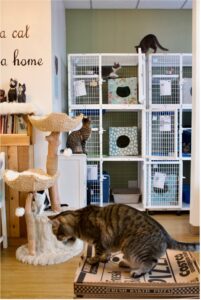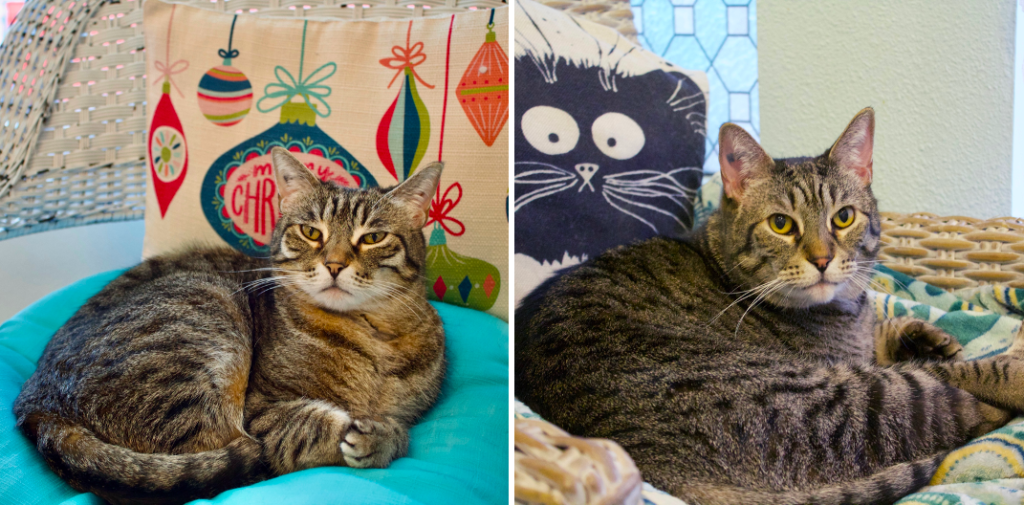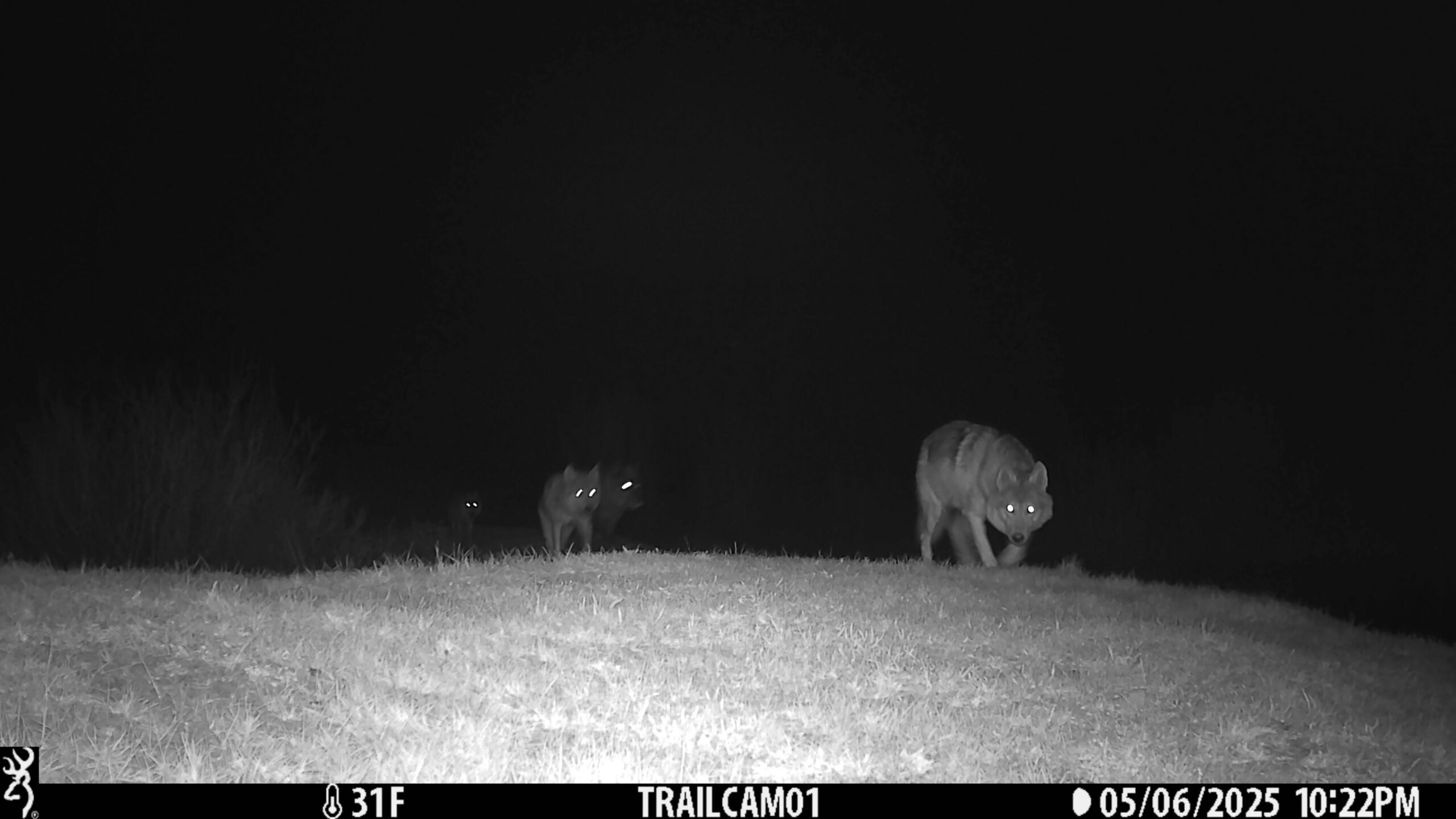(REDMOND, Wash.) — At the far end of an unremarkable strip mall in downtown Redmond, Wash., past an Irish pub, British bakery, and Japanese restaurant, is the Tiffany blue front door of The Whole Cat and Kaboodle, a cat supply store and adoption center. Four tri-level cat towers are displayed along the sidewalk in front of a large set of windows that look into the attached cat café, a spacious room filled with sunlight, wicker furniture, and 12 cats up for adoption.
Inside, a soft piano melody accompanied by the sound of chirping birds plays over the speakers . It’s a tranquil atmosphere, and all around the room are smiling visitors petting and playing with the resident cats. A couple of children giggle at the tiny gray cat bouncing across the room. A tuxedo cat is making himself comfortable on the lap of a young girl. And two stoic male Tabbies occupy a set of chairs by the window, gazing out at the scene like a couple of old folks on their front porch. Opie and Ozzie are their names. They’re brothers, nine years old, and less than three months ago, they were moments away from being euthanized.
In 2021, over 350,000 cats were surrendered by their owner to a U.S. shelter, most commonly due to behavior or health issues. Anyone who has owned a cat knows, getting your feline to stop peeing and scratching where they shouldn’t or hissing at family members and other pets can be a trying and sometimes unsuccessful process. Cats also face high risk of ailments like obesity, diabetes, urinary tract infections, and gingivitis. Unable to correct these problems—some of which require expensive medications or surgeries—owners may feel forced to surrender their loved one, or even have them euthanized.
Nancy Howard, owner of The Whole Cat and Kaboodle, is on a mission to reduce surrenders in her community by teaching cat owners how to correct unwanted behavior by listening to what she calls the wisdom of the cat. “Our saying here is this,” she said, “Any bad behavior is the result of an unmet need.”
Nancy, a petite woman with faded blonde hair and bright blue eyes, began her career in rescue work. In 2000, she opened The Sanctuary at Hidden Creek Ranch—a 5,000 sq. ft. outdoor enclosed space in Bothell, Wash., that currently houses just over 120 unadoptable cats. Through her work at a high-end pet store, she also took classes about feline nutrition.
“I started to pick up on the link between nutrition and behavior,” she said, “and then it took on a natural life of its own.” Thus, her mission was born: to see and understand the world from the cat’s perspective to prevent unnecessary shelter surrenders. The nutrition-behavior link became the foundation of her business when The Whole Cat & Kaboodle (WCK) opened in 2013.
WCK goes beyond the retail focus of most pet stores, combining product sales with comprehensive services around cat wellness, including adoption and behavioral therapy. WCK currently adopts out approximately 300 cats per year, over 80% of which require some type of rehabilitation before finding a new home.
* * *
Opie and Ozzie arrived at WCK on Monday, September 23. Inside the quiet office of the adoption coordinator, Teresa Rosenberg, the brothers emerged from their carriers — crouched low and tails down — and began inspecting the room. Opie is smaller than his brother, which is the easiest way to tell them apart. They both have stern faces with prominent nose bridges and serious eyes. Their tabby stripes are dark and form nearly identical patterns on their slightly feeble bodies. “I could tell these guys had been protein starved,” said Teresa.
The litter mates grew up in a home with their two owners, a toddler, and a dog. Though the dynamics were fine for a while, both cats eventually became aggressive, particularly toward the child and dog. They would hiss and scratch at anyone who tried to approach them. The stress on the family mounted until the owners decided to take both cats to the vet for euthanasia. But, not wanting to enact such a permanent solution for two young cats, the veterinarian instead took them home and boarded them for two weeks. They then lived with a foster for three weeks until WCK had room to take them in. “I’m so glad the vet made that decision,” said Teresa, “they were quite literally snatched from the jaws of death.”
Using the foundational nutrition-behavior link, Nancy posits that Opie and Ozzie perceived the toddler and dog as threats to their food source and an impediment to the predictability of their environment. Despite being nature’s top predator, cats are also prey animals and will be in a state of stress if their environment feels unpredictable. “They’ll assume there are predators present until they know otherwise,” Nancy said. Until then, their defenses will be up. She believes that the signs of aggression were their attempt to assert their dominance and reclaim their territory.
It’s also very common for cats in similar situations to start patrolling, i.e., marking their territory with urine. If an owner cannot successfully mitigate these behaviors, a surrender becomes more likely.
“Behavior is the cat’s way of communicating,” she explains. “And if you knew the reason behind the bad behavior it wouldn’t make you angry, it would break your heart.” To identify the reason and correct the behavior, Nancy consults the Mother Nature model and looks to the feline’s deeply prehistoric needs.
* * *
Though we consider cats to be a domesticated species, a 2017 study showed they are biologically no different than their wild ancestors. Claudio Ottoni of the University of Leuven and his team surveyed the DNA of more than 200 cats and cat remains spanning the last 9,000 years and found two major lineages that contribute genetically to the modern-day feline: the North African and Southwest Asian wildcat. For centuries, these species roamed the Earth as feral animals living off mice, rats, birds, and other small prey. When the spread of farming and civilization attracted these small animals, the cats followed, approaching human settlements for the first time. Appreciating the help in rodent control, humans had no problem letting the wild cats patrol their farms, streets, and shops. For thousands of years the two species lived harmoniously, and the cat remained mainly self-sufficient and nature-fed.
During this time, “the cat was kept not necessarily as a pet, but as useful workers,” said Elizabeth M. Hodgkins, a veterinarian of 28 years, in her book, Your Cat: Simple New Secrets to a Longer, Stronger Life. But, from the early to mid-twentieth century, as urbanization and population density increased, cats living outdoors faced more dangers. Cars became a major threat, and they faced increased risk of catching viral, bacterial, or parasitic diseases. During this time, most felines were left to fend for themselves, maintaining the independence of their ancestors though most died relatively young.
The mid to late-twentieth century held a cultural shift for the lifestyle of the cat. Indoor and outdoor spaces became smaller, life became fast-paced, and many homes were empty during the day while the family was at school and work. For humans who wanted a furry companion but lacked the time to give one constant care and attention, the self-sufficient cat was an appealing choice. The once wild predator was invited into the home where they took refuge from the outside dangers and began depending on the human for food and shelter.
Today, the cat is among the most popular pets in the U.S. and the majority live indoors. While this new lifestyle is safer, problems have surfaced as humans have failed to curate a diet and environment that aligns with the species’ needs, which remain intensely prehistoric. “These seemingly new problems are the result of man-made influences on the cat through its new indoor lifestyle,” said Hodgkins. “All can be reduced or prevented through understanding of those unnatural influences and how to correct them.”
* * *
The first step in Opie and Ozzie’s rehabilitation, as is always the first step according to Nancy, is to transition them from dry to wet (canned or raw) food. This is because cats are obligate carnivores, meaning not only do they rely on animal-based proteins to meet their nutritional needs, but they are unable to compensate for a lack of available protein by consuming plants like other mammals can. According to Hodgkins, during starvation or excessive protein restriction, “the cat is forced to disassemble its body’s constituents (proteins, enzymes, antibodies, organ tissues) to produce fuel for energy to keep the cells alive and functioning.” Research done in the 1970s and 80s showed conclusively that protein requirements in cats far exceed those of similar domesticated mammals, and a 2010 study upheld this notion.
A wet food diet is the crux of the nutrition-behavior link, says Nancy. “Raw food is the gold standard for feeding your cat because it’s what best mimics what would be true in nature.” The Mother Nature model suggests that a diet lacking in protein, or high in processed protein, is directly linked with territorial issues like aggression and patrolling. “A cat will think that a predator has come into their territory, taken all the nutritious prey, and left them with dry scraps,” says Nancy.
The anatomy of the modern-day cat, despite centuries of domestication, suggests that they’ve retained their need for an all-meat diet. Unlike the omnivorous canine who evolved alongside humans, adapting to their diet containing plant and vegetable matter, the cat evolved during prehistoric times and then stopped. Their teeth are specialized for grasping and tearing flesh and compared with the dog, their jaw has far more restricted side-to-side and front-to-back mobility, limiting its ability to grind vegetation. The cat’s eyes and ears, positioned forward on the head to provide impeccable vision and hearing at night, and their retractable claws are all features that allow the cat to track and bring down wild prey.
The cat’s stomach, appendix, and segments of their gastrointestinal tract most associated with digestion of vegetable matter are smaller than those in dogs and their intestine to body length ratio is shorter than other mammals. Additionally, cats must consume their vitamin A from animal sources because they’re unable to make this essential vitamin from the beta carotene found in plants like other mammals can. This all suggests an adaptation to the digestion of a higher meat and calorie dense diet.
An easily overlooked characteristic of cats is that they evolved to get their water intake from food. As a desert species, cats are capable of surviving for long periods without water and will naturally consume very little free water. Consequently, according to Hodgkins, “they have highly concentrated urine compared to that of the dog.” Cat urine already contains high amounts of metabolic waste so inadequate water consumption will only concentrate it further which can be harmful to their urinary tract. And due to their low thirst drive, cats will not naturally compensate for a lack of water by drinking freely from another source.
“I see so many cats that are living in a constant state of dehydration,” says Nancy. “It’s like being hungover all the time. I bet when you’re hungover you’re probably a little cranky too.” Chronically dehydrated cats show little tolerance for outside stimulation such as interactions with children, other pets, and even their owners.
Like most felines that are accustomed to dry food, Opie and Ozzie were reluctant to transition. They even had to be bottle-fed goat’s milk after three days of barely eating. But with time, patience, and some CBD oil to stimulate their appetite, both cats are now enjoying a hearty plate of raw food every night.
* * *

Ozzie climbs on pizza boxes meant for a staff meeting. Neko,
Freddie, Otter Pop, KC, and Kipsy can also be spotted (clockwise) [Credit: Josie Fenske].
It’s 5:00 p.m., a Friday evening in mid-November, and the last customer leaves the shop. Marissa Lazona heads into the café to wrangle the cats for dinner time. A light rain falls outside. The faux fireplace keeps the room warm and cozy. She first picks up Opie out of his usual chair by the window and places him in his room and then grabs Ozzie off the top tier of the cat tower. He gives a small groan of annoyance as she carries him.
Allie Satalich, one of WCK’s newest employees, rolls in a cart with twelve plates of dinner on it. Each is labeled with the cat’s name and their specialized assortment of food based on diet and protein preference. The felines recognize the sound of the cart and begin meowing and aggressively rubbing the walls of their rooms. Opie lets out a few quiet chirps and goes into his bed. Ozzie sits patiently in front of his door. After some trial and error, both boys have developed a protein preference. Tonight, Opie is eating raw turkey, and Ozzie is having a mix of raw chicken and rabbit. Allie opens their doors and slides the plates in. Ozzie digs in right away, contributing to the symphony of loud wet smacks coming from the feasting cats. Opie pokes his head out of the hole, confirms his food is there, and retreats back inside to groom himself. Many of the cats will finish their meals throughout the night. Ozzie however finishes his entire plate, licks the bottom of his paw, and goes to bed.
As I watch the cats enjoying all kinds of various fish and poultry, seeing how visibly healthy and happy they are, I can’t help but question how feeding processed dry kibble to an obligate carnivore ever became the norm.
* * *
It began in the early 1900’s. An invention made its way from England to the U.S. James Spratt made the first dog biscuit using wheat meals, vegetables, beetroot, and meat. U.S. manufacturers started diversifying the product, selling canned horse meat for dogs and canned fish for cats.
During WWII, when metal and meat were rationed, pet food was classified as “non-essential.” The market shifted and companies began making dry kibble. Compared to canned meat, kibble is significantly cheaper to make and lasts longer—two of the main reasons cat owners choose dry food today. Eventually, over 500 brands were in on the action, but Purina rose to the top with their innovative kibble making process.
The extrusion process involves heating dough until it puffs up into an airy kibble, explains Hodgkins. However, the dough will not puff up unless there is substantial starch present, which is why dry food commonly contains rice, corn, and other grains. The process also removes moisture to increase shelf life. While this product is perfectly suitable for a dog, it does not meet the dietary requirements of the cat.
Nonetheless, dry cat food became standard, and veterinarians started seeing more cats suffering from bladder diseases, UTI’s, diabetes, skin rashes, weakened immune systems, and obesity. Pet food companies were quick to blame the cat for its sedentary lifestyle and owners for over-feeding. “No one thought to stop feeding cereal to cats,” said Hodgkins, “Instead, the industry devised yet more additives for the existing flawed diets to try to correct the problems.”
In response to cat obesity, scientists decided to remove fat from their recipes and replace it with dried cellulose, a fibrous plant-based compound. Owners were also encouraged to feed their cats less. When the indigestible fiber started causing damage to the cat’s digestive tract, increased hairballs and vomiting became problems. The industry’s solution was to add beet pulp, another plant-based fiber, to “gently move hair through the gastrointestinal tract.” Trying to compensate for these imbalances, the cat’s immune system is thrown into a frenzy and their skin and fur take a toll.
The result is excessive shedding and dandruff which is a nightmare for owners with allergies, so Purina scientists discovered an “antibody found in chicken eggs” that, when added to their food, could neutralize the allergen in the cat’s saliva. However, a closer look at the study reveals that this antibody is, in fact, not naturally found in chicken eggs, but instead it requires the chickens to be “exposed to the protein” first. Dry food is even marketed as a product that can clean cat’s teeth and prevent gingivitis, despite studies showing it has the opposite effect.
This is a lot of running around patching holes. Perhaps the solution is a lot simpler.
* * *
It’s a quiet Friday afternoon in the café. Opie and Ozzie have been at The Whole Cat & Kaboodle for almost three months. Though not yet adopted, they are two favorites with the visitors and regulars. Today, a mother watches as her daughter lovingly strokes Opie, who is curled up in his favorite chair by the window, and her son sends Ozzie flying around the room chasing a red laser. Both cats are noticeably more toned, their coats silky smooth. On WCK adoption’s page, the brothers are listed as a “bonded pair” with the idea that someday they’ll be adopted together. And now that their bodies are being fueled in the way nature intended, Nancy is confident in a successful adoption.
“You can’t look at health and behavior problems from the point of view of the human, the groomer, the breeder, or the veterinarian,” said Nancy, “but from the point of view of the cat.” They know what they need, and it’s our job to follow their lead, she explained. When it comes to curating a diet to help our beloved felines thrive, the prehistoric needs of the once wild predator should be a guiding light.
“To ignore the wisdom of the cat is folly, hubris, and so human.”


